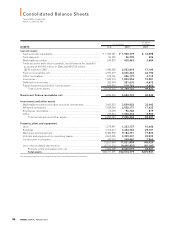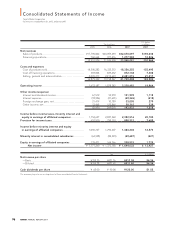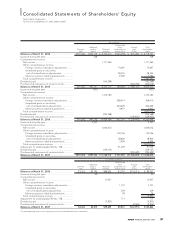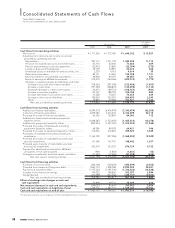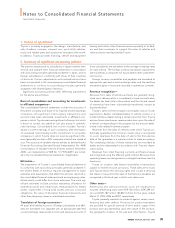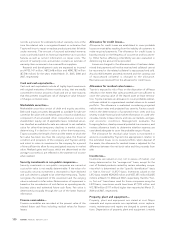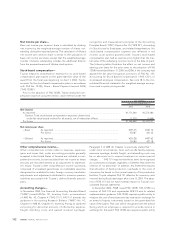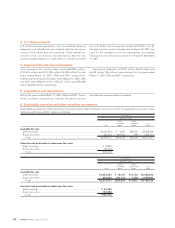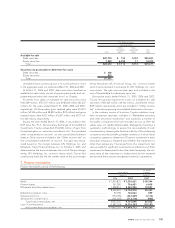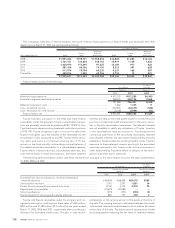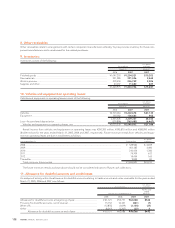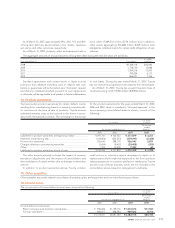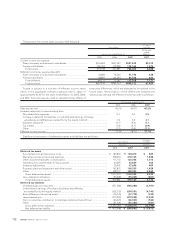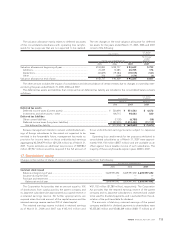Toyota 2007 Annual Report Download - page 105
Download and view the complete annual report
Please find page 105 of the 2007 Toyota annual report below. You can navigate through the pages in the report by either clicking on the pages listed below, or by using the keyword search tool below to find specific information within the annual report.
ANNUAL REPORT 2007 103
to initially measure the cost of employee services received in
exchange for an award of liability instruments based on its cur-
rent fair value; the fair value of that award will be remeasured
subsequently at each reporting date through the settlement
date. Changes in fair value will be recognized as compensation
cost over that period. Although Toyota is required to imple-
ment the Standard as of the beginning of the first interim or
annual period that begins after June 15, 2005 under Statement
No.123(R), the Securities and Exchange Commission has
amended the compliance date and Toyota adopted the
Standard from the fiscal year beginning on April 1, 2006. See
note 18 to the consolidated financial statements for the impact
of the adoption of this Standard on Toyota’s consolidated
financial statements.
In May 2005, FASB issued FAS No. 154, Accounting Changes
and Error Corrections – a replacement of APB No. 20 and FAS
No. 3 (“FAS 154”). FAS 154 replaces APB Opinion No. 20,
Accounting Changes, and FAS No. 3, Reporting Accounting
Changes in Interim Financial Statements, and changes the
requirements for the accounting for and reporting of a change
in accounting principle. FAS 154 applies to all voluntary
changes in accounting principle. It also applies to changes
required by an accounting pronouncement when the pro-
nouncement does not include specific transition provisions.
APB Opinion 20 previously required that most voluntary
changes in accounting principle be recognized by including in
net income of the period of the change the cumulative effect of
changing to the new accounting principle. FAS 154 requires ret-
rospective application to prior periods’ financial statements of
changes in accounting principle. Toyota adopted FAS 154
effective for accounting changes and corrections of errors made
in fiscal year begun after December 15, 2005. The adoption of
FAS 154 did not have material impact on Toyota’s consolidated
financial statements for the year ended March 31, 2007.
In September 2006, FASB issued FAS 158. FAS 158 requires
employers to recognize the overfunded or underfunded status
of their defined benefit postretirement plans as an asset or a
liability on their balance sheets, and to recognize changes in
that funded status in the year in which the changes occur
through comprehensive income. Toyota adopted the provisions
regarding recognition of funded status and disclosure under
FAS 158 as of the end of the fiscal year ending after December
15, 2006. See note 19 to the consolidated financial statements
for the impact of the adoption of the provisions on Toyota’s
consolidated financial statements.
Recent pronouncements to be adopted
in future periods—
In February 2006, FASB issued FAS No. 155, Accounting for
Certain Hybrid Instruments (“FAS 155”), which permits, but
does not require, fair value accounting for any hybrid financial
instrument that contains an embedded derivative that would
otherwise require bifurcation in accordance with FAS No. 133,
Accounting for Derivative Instruments and Hedging Activities
(“FAS 133”). The Statement also subjects beneficial interests
issued by securitization vehicles to the requirements of FAS
133. FAS 155 is effective as of the beginning of first fiscal year
that begins after September 15, 2006. Management does not
expect this Statement to have a material impact on Toyota’s
consolidated financial statements.
In March 2006, FASB issued FAS No. 156, Accounting for
Servicing of Financial Assets (“FAS 156”), which amends FAS
No. 140, Accounting for Transfers and Servicing of Financial
Assets and Extinguishments of Liabilities (“FAS 140”), with
respect to the accounting for separately recognized servicing
assets and servicing liabilities. FAS 156 is effective for fiscal year
beginning after September 15, 2006. Management does not
expect this Statement to have a material impact on Toyota’s
consolidated financial statements.
In September 2006, FASB issued FAS No. 157, Fair Value
Measurements (“FAS 157”), which defines fair value, establishes
a framework for measuring fair value and expands disclosures
about fair value measurements. FAS 157 is effective for financial
statements issued for fiscal year beginning after November 15,
2007 and interim period within the fiscal year. Management is
evaluating the impact of adopting FAS 157 on Toyota’s consoli-
dated financial statements.
In September 2006, FASB issued FAS 158. FAS 158 requires
employers to measure the funded status of their defined benefit
postretirement plans as of the date of their year-end statement
of financial position. This provision in FAS 158 regarding a mea-
surement date is effective for fiscal year ending after December
15, 2008. Management is evaluating the impact of adopting this
provision on Toyota’s consolidated financial statements.
In February 2007, FASB issued FAS No. 159, The Fair Value
Option for Financial Assets and Financial Liabilities – Including
an amendment of FASB Statement No. 115 (“FAS 159”). FAS
159 permits entities to measure many financial instruments and
certain other assets and liabilities at fair value on an instrument-
by-instrument basis and subsequent change in fair value must
be recorded in earnings at each reporting date. FAS 159 is
effective for fiscal year beginning after November 15, 2007.
Management is evaluating the impact of adopting FAS 159 on
Toyota’s consolidated financial statements.
In June 2006, FASB issued FASB Interpretation No. 48,
Accounting for Uncertainty in Income Taxes – an interpretation
of FASB Statement No. 109 (“FIN 48”). FIN 48 clarifies the
accounting for uncertainty in tax positions and requires a com-
pany to recognize in its financial statements, the impact of a tax
position, if that position is more likely than not to be sustained
on audit, based on the technical merits of the position. FIN 48 is
effective for fiscal year beginning after December 15, 2006.
Management is evaluating the impact of adopting FIN 48 on
Toyota’s consolidated financial statements.
Reclassifications—
Certain prior year amounts have been reclassified to conform to
the presentations for the year ended March 31, 2007.



